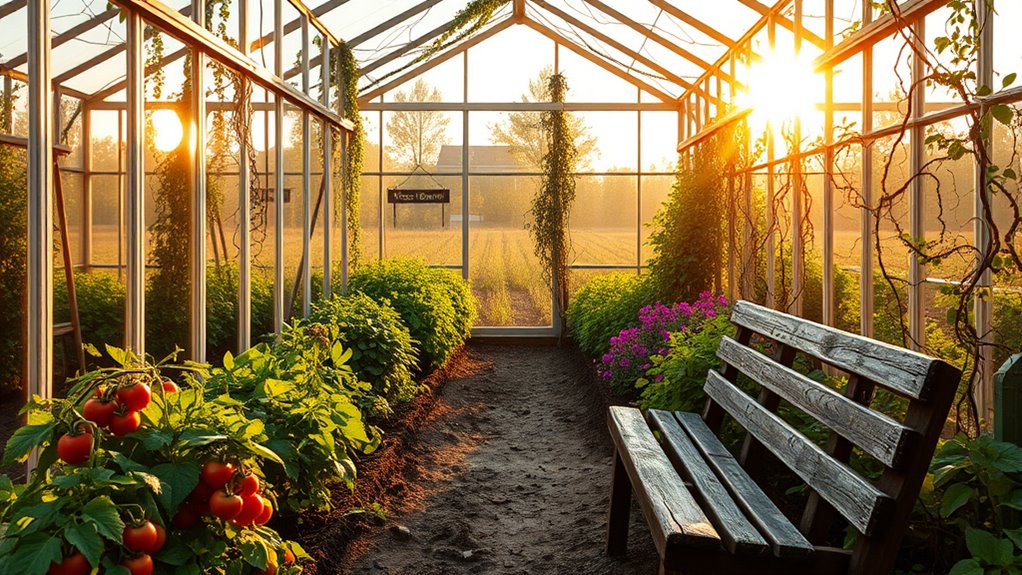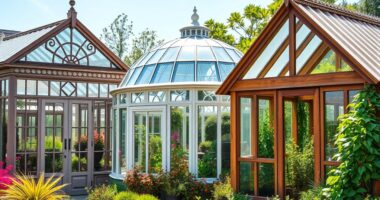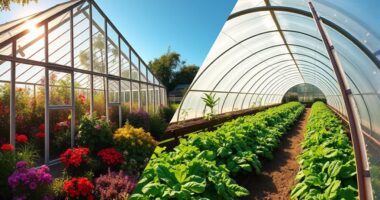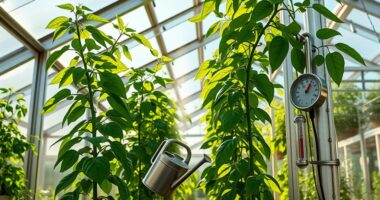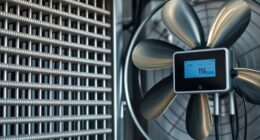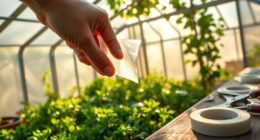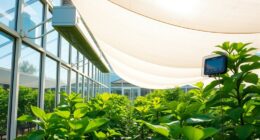A greenhouse is a structure that creates ideal growing conditions for plants by trapping solar energy. By using this controlled environment, you can protect plants from extreme weather, extend growing seasons, and boost crop yields. With the right materials, such as glass or polycarbonate, and effective environmental controls, you can optimize temperature and humidity. This leads to healthier plants and better harvests. Discover more about greenhouse benefits and types to maximize your gardening success.
Key Takeaways
- A greenhouse is a structure that enhances plant growth by trapping solar radiation and maintaining stable temperatures through the greenhouse effect.
- It allows for precise control of temperature, humidity, and light, leading to accelerated plant growth and extended growing seasons.
- Greenhouses protect plants from extreme weather, pests, and diseases, reducing the need for chemical interventions.
- Investing in a greenhouse can increase yields and profitability by creating ideal growing conditions for high-value crops year-round.
- The controlled environment minimizes production risks, making greenhouse cultivation a reliable option for sustainable agriculture.
Understanding the Structure and Function of a Greenhouse
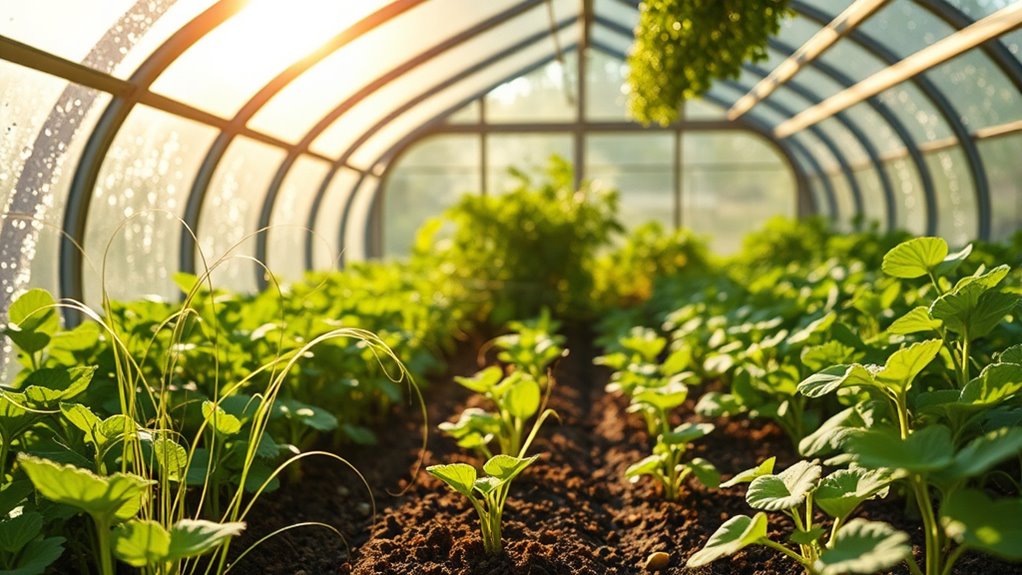
A greenhouse serves as an essential sanctuary for plants, enhancing their growth conditions. It relies on the greenhouse effect, trapping solar radiation to maintain a stable temperature.
This warmth, coupled with transparent materials like glass or polycarbonate, allows sunlight to penetrate while preventing heat from escaping. The soil acts as a thermal mass, releasing stored heat at night, ensuring your plants stay cozy.
You gain precise control over temperature, humidity, and light, which extends growing seasons considerably. With these ideal conditions, your plants can thrive, enjoying excellent photosynthesis and nutrient uptake.
Key Materials Used in Greenhouse Construction
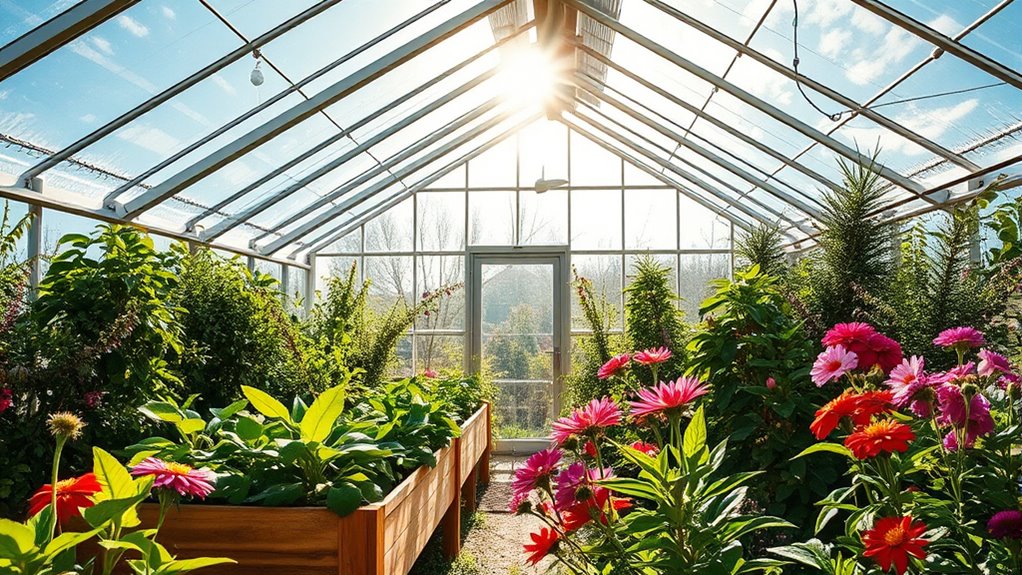
When constructing a greenhouse, selecting the right materials is essential for ensuring durability and efficiency.
For the frame, you can choose between wood, which is aesthetically pleasing, and metal options like aluminum, known for its corrosion resistance. Galvanized steel is another solid choice, offering additional protection against rust.
When selecting a frame, consider wood for aesthetics or aluminum and galvanized steel for durability and rust resistance.
For covering, glass provides excellent insulation but can be heavy and costly; polycarbonate panels are lightweight and easy to install. If you’re looking for affordability, poly film is a great option.
Your base can be concrete for stability or aggregates for better drainage.
Finally, consider wooden or metal shelving for your internal layout, ensuring you maximize space and maintain organization throughout your greenhouse.
The Importance of Environmental Control in Greenhouses
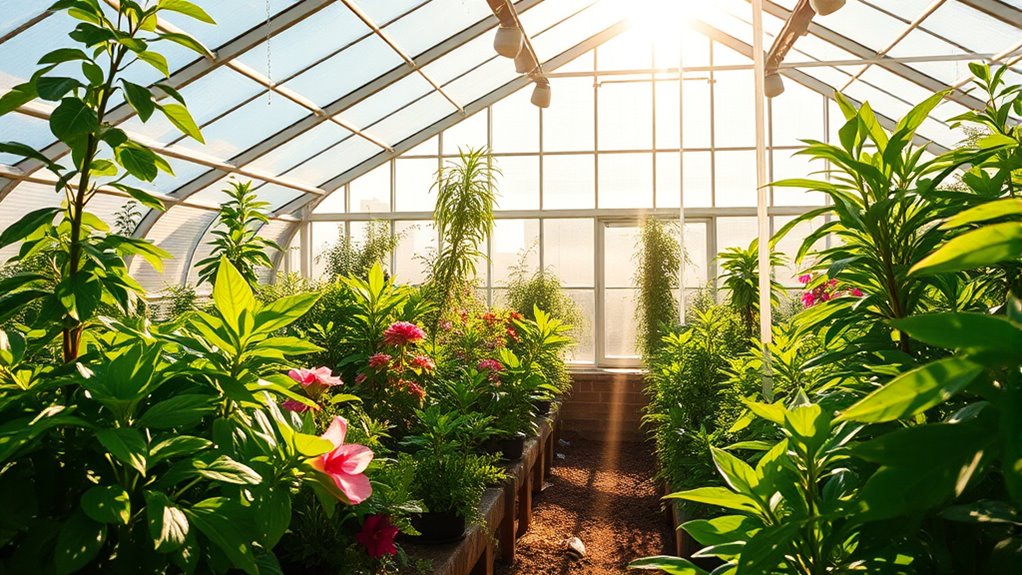
When you’re managing a greenhouse, keeping the right temperature and humidity levels is essential for healthy plant growth.
You’ll need to employ effective temperature regulation techniques and humidity management strategies to create the ideal environment.
Temperature Regulation Techniques
Temperature regulation in greenhouses is essential for creating the ideal environment for plant growth.
You can implement various heating systems, like electric heaters for small spaces or solar heating to store warmth for nighttime. For larger greenhouses, consider fuel-based systems.
Effective cooling methods include automatic vent openers and fans for ventilation, while evaporative cooling pads can help lower temperatures.
Smart climate controllers enable remote regulation of temperature and humidity, enhancing your control over the environment.
Prevent heat loss with insulation materials, like UV-rated plastic, and consider energy-efficient strategies, such as thermal curtains and solar panels.
Humidity Management Strategies
Maintaining the right humidity levels in your greenhouse is essential for fostering healthy plant growth.
Too much humidity can lead to fungal diseases, while too little can stress your plants.
Ideally, you want to keep humidity between 50% and 70%.
Here are some effective humidity management strategies you can employ:
- Ventilation: Use natural or mechanical ventilation to enhance air circulation and reduce moisture buildup.
- Dehumidifiers: Consider using dehumidifiers to remove excess moisture, especially in humid climates.
- Watering Techniques: Water plants only when necessary, and utilize drip irrigation to minimize evaporation.
Benefits of Growing Plants in a Greenhouse
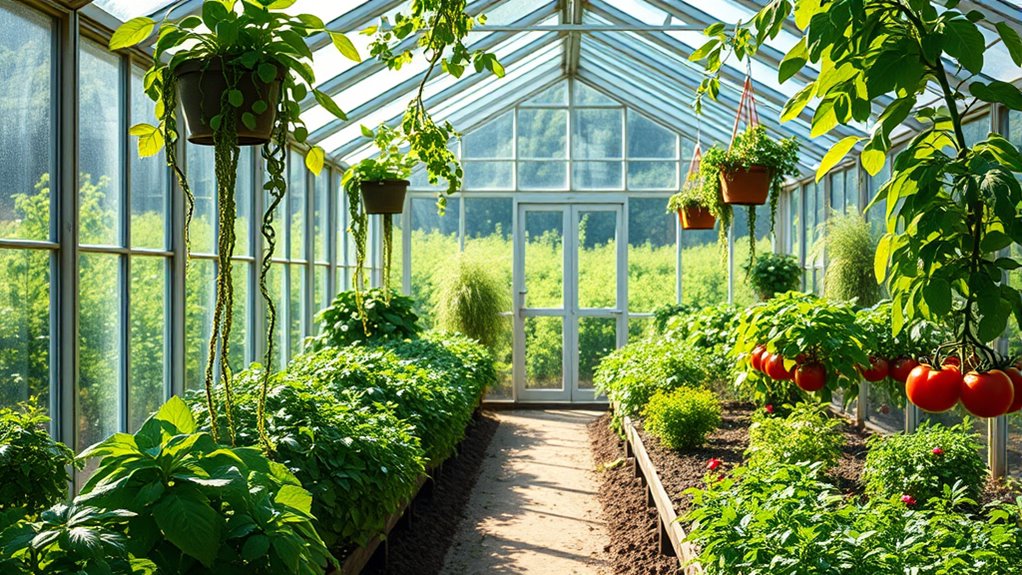
Growing plants in a greenhouse offers a range of advantages that can greatly enhance your gardening experience.
You’ll enjoy stable temperatures, protecting your plants from extreme weather. With controlled humidity and optimized light, your plants will thrive and grow faster.
Greenhouses also allow you to plant earlier in spring and harvest later in fall, extending your growing season considerably. Plus, they shield your plants from pests and diseases, reducing the need for chemicals.
You’ll conserve water through efficient irrigation methods and minimize evaporation. Ultimately, the controlled environment promotes better root development and overall plant health, leading to increased crop yields.
Embrace the benefits of greenhouse gardening for a more productive and enjoyable experience!
Economic Advantages of Greenhouse Cultivation
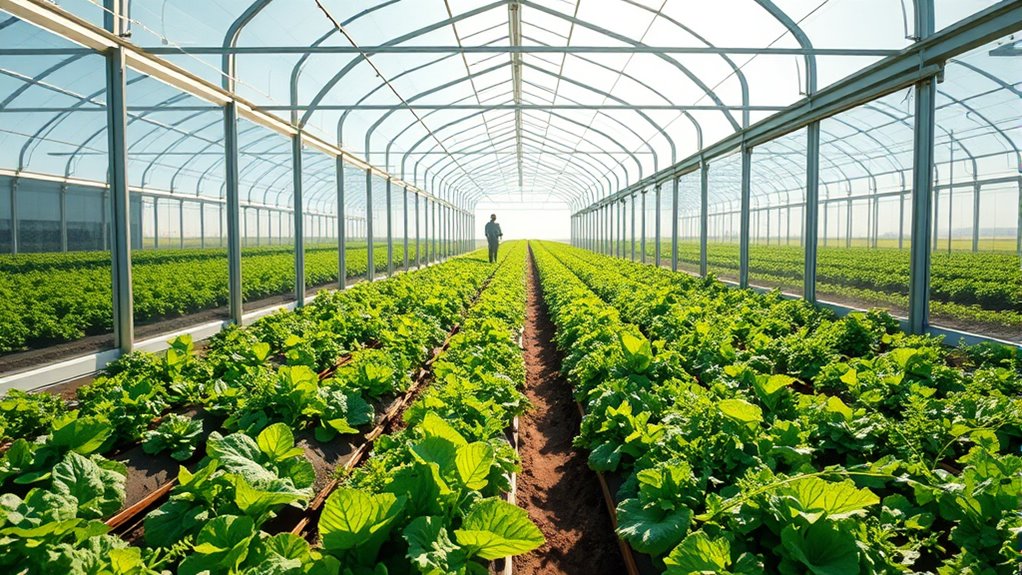
While greenhouse cultivation involves an initial investment, the economic advantages it offers can make it a highly rewarding venture.
By creating ideal growing conditions, you’ll likely see increased yields and the ability to produce high-value crops that fetch better market prices.
Creating optimal growing conditions can lead to higher yields and access to lucrative market opportunities.
Consider these benefits:
- Reduced Production Risks: The controlled environment minimizes damage from extreme weather and pests.
- Year-Round Production: You’ll have the potential for continuous revenue streams, enhancing your profitability.
- Efficient Resource Use: Greenhouses enhance water and energy usage, cutting operational costs over time.
Different Types of Greenhouses and Their Applications
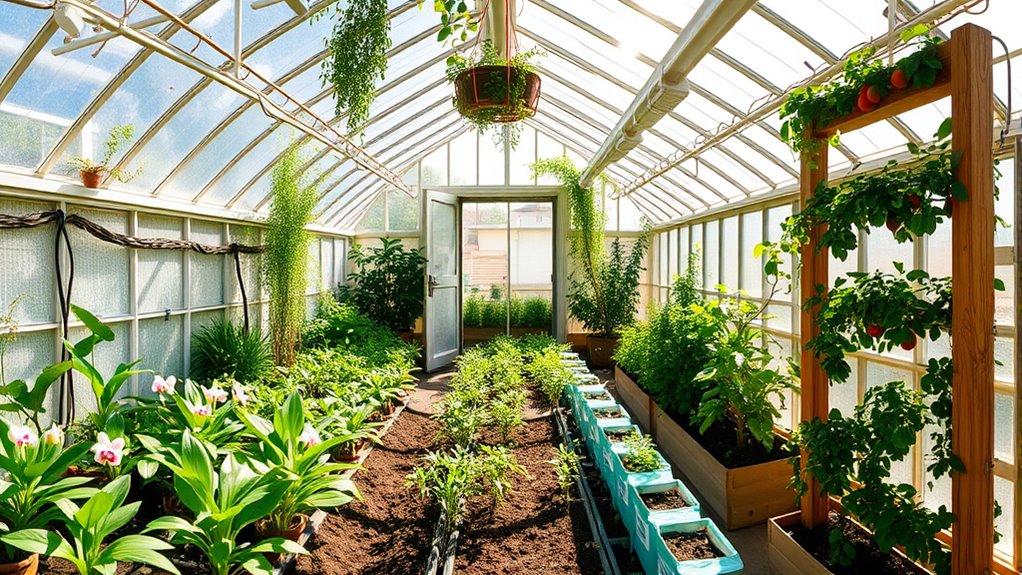
There are several types of greenhouses, each designed for specific applications and suited to different gardening needs.
Freestanding greenhouses offer versatility for diverse plant cultivation, while attached greenhouses maximize limited space. Cold-frame greenhouses are perfect for frost protection, and hoop houses are ideal for beginners due to their easy setup. A-frame greenhouses provide excellent ventilation and light.
In terms of materials, glass greenhouses allow great light transmission, but polycarbonate and aluminum options are durable and economical.
Commercial applications include nursery, vegetable, and floriculture greenhouses, each tailored to specific crops. Specialized types like hydroponic and educational greenhouses serve unique purposes, enhancing growth and learning.
Choose the right greenhouse type to optimize your gardening experience!
Frequently Asked Questions
How Much Does a Greenhouse Cost to Build and Maintain?
Building a greenhouse can cost you anywhere from $3,071 to $16,209, depending on size and materials.
For basic models, you might spend around $5 to $10 per square foot.
Maintenance costs include cleaning, pest control, and energy for climate control, which can add up.
Regular inspections and potential material replacements, like plastic sheeting, are also necessary.
What Plants Grow Best in a Greenhouse Environment?
You might think growing plants outdoors is enough, but a greenhouse lets you cultivate a wider variety with greater success.
In this controlled environment, bananas, tomatoes, and herbs like parsley thrive, while figs and cucumbers flourish too.
You can enjoy year-round production of Meyer lemons and tender avocados.
Even unique options like cucamelons and tea plants can thrive, making your gardening experience more diverse and rewarding.
Embrace the possibilities!
How Do I Choose the Right Greenhouse Size for My Needs?
To choose the right greenhouse size for your needs, assess your available space and budget first.
Think about the types of plants you want to grow and their space requirements. If you’re just starting, a small greenhouse might suffice, but consider future expansion.
Plan for efficient layouts and maintenance costs, too.
Don’t forget to check local zoning laws, as they may limit your greenhouse size and design options.
Can I Use a Greenhouse Year-Round in All Climates?
Yes, you can use a greenhouse year-round in all climates, but you’ll need to adapt it to your specific conditions.
In cold climates, focus on insulation and passive solar design to retain heat.
For warm climates, install cooling systems and effective ventilation.
You can also customize your greenhouse with features like thermal mass and climate control systems, ensuring ideal conditions for your plants regardless of the weather outside.
What Are Common Pests and Diseases in Greenhouses?
Imagine your plants thriving under a protective dome, yet hidden threats lurk nearby.
In greenhouses, common pests like aphids and spider mites suck the life from your greenery, while diseases like powdery mildew coat leaves in white despair.
Neglecting ventilation or overwatering can release these foes.
Conclusion
To summarize, a greenhouse is more than just a structure; it’s a dynamic environment that enhances your growing potential. With the ability to boost plant growth by up to 30% compared to traditional gardening, it’s clear why so many gardeners invest in one. Whether you’re looking to extend your growing season or improve crop yields, a greenhouse can make a significant difference. So, if you’re serious about gardening, consider making this investment for your green thumb pursuits!
